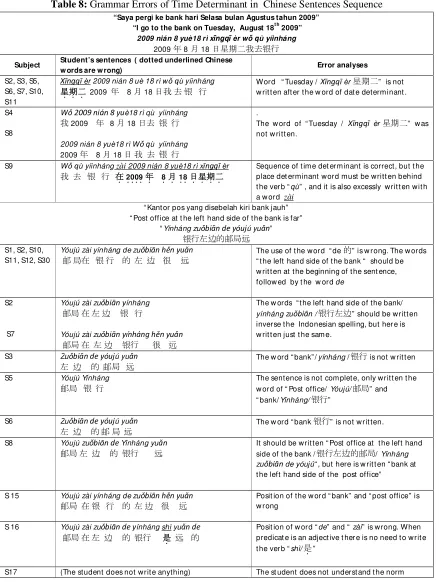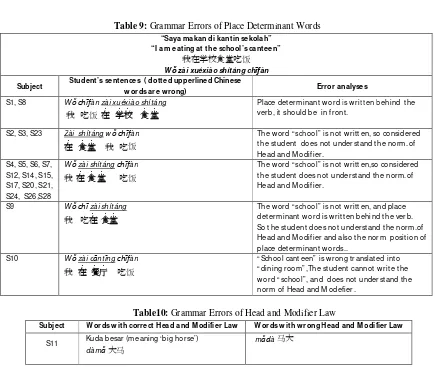www.textroad.com
Problematic Grammar of Chinese Sentences Faced
by Students Having Indonesian as Their Mother Tongue
Ong Mia Farao Karsono
Petra Christian University Surabaya (Indonesia)
ABSTRACT
This paper examine the grammatical problems faced by Surabaya students having Indonesian as their mother tongue when constructing Chinese sentences. A qualitative descriptive method consisting test materials made by 30 students learning Chinese as a second language was used. Some grammatical errors in the Chinese sentences were found. Problematic in writing Chinese sentences consists of: sequence errors of place and time determinant words; grammatical errors about the Modifier and Head norm in arranging words; errors using the three kinds of words de, “的de”, “得de”, and “地de”. All these errors were influenced by their Indonesian mother language, while in arranging Chinese sentences, it was also interferences by the English grammatical norm to be. To overcome these problematics, the best solution is using contrasive analyses, which expose the differences between these two languages, and thereby clarify the point of differences.
Key words: Problematic Grammar error Chinese Indonesian
INTRODUCTION
Mother tongue Indonesians at the early stage of learning Chinese, frequently face problematic situations. These difficulties happened because a different grammatical rule exists between the two languages. Among others,in combination words, Indonesian language adhere an Indonesian law of Head and Modifier. For example “ibu saya” (meaning ‘my mother’) , the word “saya” ( I ) explained the word “ ibu” ( mother ).While Chinese adheres an inverse law of Modifier and Head, so this word combination in Chinese will be “wǒ māma 我妈妈, the word wǒ explained the word māma. Another problematic is the application of the particle “de” whose latin spelling is the same but possesses three dfferent Chinese characters “..的”, “.得”, and “地.”. These three “de” words have a different kind of aplication, which cause the student frequently making mistakes. Also in writing the sequence of the time and place determinants, the Chinese language adhere a system from a bigger condition toward the smaller, meanwhile in Indonesia these determinants follow the writing rule from a smaller condition towards the bigger.
MATERIALS AND METHODS
Sequence Norm of Writing Time and Place Determinants.
Common errors in writing the sequence of time and place determinants from a bigger condition toward the smaller condition according the research of Huang (2009:3) can be shown in the next table.
Table 1: Chinese Sentences with Correct and Wrong Writings of Time or Place Determinants ( Huang 2009:3)
Indonesian sentence W rong translation Correct translation (1) Hari Senin 17 Agustus tahun 2009.
1 2 3 4
(2) Surabaya Jaw a Tim ur Indonesia 3 2 1
星期一 十七日 八月 二〇〇九 年 4 3 2 1
泗水 东爪哇 印尼 3 2 1
二〇〇九 年 八月 十七日 星期一。 1 2 3 4
2009 nián 8 yuè 17 rì xingqi yi
印尼(国) 东 爪 哇(省) 泗 水(市) 1 2 3
Table 2: Chinese Sentences with Correct and Wrong Writings of the Word “ de的.” ( Huang 2009:3)
Indonesian sentence W rong translation Correct translation
(3) Taman yang di tengah lapangan sekolah. 4 3 2 1
公园 的中央 广场 学校. 4 3 2 1
学 校 广 场 中央 的 公园 1 2 3 4
Xuéxiào guǎngchǎng zhōngyàng de gōngyuán
The example in sentence (3) is rather special because it contains the word “ de的” . When in a sentence contain this word, the translation from Indonesian sentences to Chinese must alter the gramatical structure. The word behind “ de的” must translated first. As in the above example, the word “taman” (garden) has to be written in front of the sentence.
Sequence Norm of Time / Place Determinants with Verbs
Time /place determinants must be written in front a verb. Usually in Indonesian sentences, these determinants is placed at the end of sentence, but may also be written in the middle or at the beginning of the sentence (Alwi et al, 2003:367). Next is a comparison example of these determinants in Indonesian and Chinese.
Table 3: Comparison of Indonesian and Chinese Sentences
Indonesian sentences Chinese sentences
(4) M ereka m akan di kantin sekolah
(They are eat ing at t he school’s cant een)
他们 在 学校 食堂 吃饭
Tāmen zài xuéxiào shítáng chīfàn
(5) Dia m em ot ong r ambut nya kemarin
(He cut his hair yest erday)
昨天 他 剪 他的头发
Zuótiān tā jiǎn tā de tóufa
The Law of Modifier and Head in Chinese Word Structure
Chinese words combination adhered the law of Modifier and Head, in the understanding that the word explaining is written in front, while Indonesian adhere an oposite Law of Head and Modifier.
Table 4: Comparison of Indonesian and Chinese Sentence According the Head and Modifier Law
Indonesian sentence struct ure
wit h the M odifier and Head Law Chinese w ord structure dìngyǔ 定语 w ith t he Head and M odifier Law
Correct sentence W rong sentence
M ajalah baru
Xīn huàbào (新画报)
Baru m ajalah ( in Indonesian) M agazine new
Huàbào xīin (画报新)
M ajalah bar u ( in Indonesian) New m agazine
The norm using the three words de “的”, “ 地”,“得”
Table 5: Chinese Word “de的” Writing Norm
N oun/ pronoun Adjective de 的 N oun Indonesian m eaning English meaning
Xuéxiào学校 de “的” Lǎoshī老师 Guru sekolah School t eacher
Huā花 de “的” Cì刺 Duri bunga Flower’ s t horn
Tā他 de “的” Kǒu口 M ulut dia His m out h
Cōngmíng聪明 de “的” Rén人 Orang (yang ) pandai Clever m an
Dà大 de “的” Mǎ 马 Kuda (yang) besar Big horse
This word de “ 地” is used after an adjective, then followed by a verb. The following table shows the writing norm of the word de “ 地” . According Qian (1995: 284-285) the word de “ 地” is usually used to explain the subject and picturing the effort in progress. Like the following example.
Table 6: Chinese Word “de 地” Writing Norm
Adjective de “ 地” Verb Indonesian meaning English meaning
Jī dòng
激动
de
地
shuō 说
Berkat a dengan terharu Excitedly speaking Jī dòng De Shuō
激 动 地 说
The word “de得” is used after a verb, then followed by an adjective. The following table shows the writing norm of the word “de得” in a sentence example in Table 7. According Xing (2001: 279) the word “de得” is
written between the centre word called zhōngxīnyǔ (中心语) and the complement word called bǔyǚ(补语) Liu and Pan (2001:590) explicited that the word “de 得” which is written behind a verb, is to show the condition of the verb done by someone / animal / object, like in Table 7.
Table 7: Chinese Word “de得” Writing Norm
Verb/ centre w ord de “得” Adverb/ adjective Indonesian meaning English m eaning Duō多 (cent re word) de “得” Hěn很 (Adverb)
Sangat banyak Very m uch
Duō de hěn
多“得”很
Pǎo de kuài
跑 得 快
Larinya cepat Running quickly
Research Method
This paper uses a qualitative descriptive method. The basic thinking using this method is because data consists of sentences. According Miles & Huberman (1992:1) and Moleong (2007:157) analyses result of sentences is more suitable by qualitative descriptive method. Sunarto (2001:132) also explicited that a qualitative paradigm reseach posseses a phenomenal analogic character, not numeric. Meanwhile, the descriptive explanation is descriptive, meaning as it is, and no experimentations were done. A similar remark was also made by Bogdan & Biklen (1992: 10) by stating that datas have a descriptive character when the discourse as a specific qualitative approach have a natural character. Besides that, the instrumental research was done by the reseacher herself.
Errors made by the 30 students were categorized according kind of errors , then sorted in a table to analyse the reasons of the errors, and finally discover the problematic causes. For legimitation, similar data from other subjects were observed and compared.
Appearing Problematics
Table 8: Grammar Errors of Time Determinant in Chinese Sentences Sequence “Saya pergi ke bank hari Selasa bulan Agustus tahun 2009”
“I go to the bank on Tuesday, August 18t h 2009”
2009 nián 8 yuè18 rì xīngqī èr wǒ qù yíinháng
2009年8月18日星期二我去银行
Subject Student’s sentences ( dotted underlined Chinese
w ords are w rong) Error analyses place det erminant word must be writt en behind t he ver b “qù” , and it is also excessly writ t en wit h
“ Saya lahir di Surabaya, Jaw a Tim ur, Indonesia”
Here the sequence of wr it ing place det erminent is contrary, it should be w rit t en: country first, follow ed by province East Java, t hen cit y
Table 9: Grammar Errors of Place Determinant Words
“Saya makan di kantin sekolah” “I am eating at the school’s canteen”
我在学校食堂吃饭
Wǒ zài xuéxiào shítáng chīfàn
Subject Student ’s sent ences ( dotted upperlined Chinese
w ords are wrong) Error analyses t he student does not underst and t he norm.of Head and M odifier. Head and M odifier and also t he norm position of place det erminant words..
Table10: Grammar Errors of Head and Modifier Law
Subject W ords with correct Head and M odifier Law W ords w ith wrong Head and M odifier Law
S11 Kuda besar (m eaning ‘big horse’)
dàmǎ大马
mǎdà马大
Solution to Solve Grammatical Problematics
To overcome syntax errors, a taxonomy classification according Dulay and Burt (in Yulianto, 2008a:8) or a comparative taxonomy or contrasive analyses can be used. Lado (in Liu, 2005:17) stresses that in mastering the mother tongue structure can have a positive or negative effect. If the target language structure is identic as their mother tongue language it will give a positive influence, and the oposite if it is different. With comparing the grammatical law of the two languages, the student will be more easy to remember. While applying the three kinds of de, can be done by contrasting the using of these three kinds of “de” “的” , “地” , and “得”.
CONCLUSION
Errors in applying the three kinds of the word de, which are “的”, “地”, and “得” , are caused by their same spelling de. While the Chinese character is different and the method for applying them in a sentence is also different. About the law of Modifier and Head in Chinese, when students were asked to write combination of two words, they master it correctly, but if it is randomed in a sentence, a problematic start happening. Time and place determinants which must be written in front of a verb in Chinese, are frequenty mistakenly written. Students sometimes add the verb “shì/是.” before the adjective, this is because of interferences by the English
grammatical norm to be. Most of these problems can be solved by contrasting their mother tongue language against Chinese.
REFERENCES
Alwi, Hasan. Dardjowidjojo, Soenjono. Lapoliwa, Han. Anton M., Moeliono. 2003. Tata Bahasa Baku Bahasa
Indonesia. Jakarta: Balai Pustaka.
Bogdan, Robert C. & Biklen, Sari Knopp. 1992. Qualitative Research forEducation: An Introduction to Theory
and Methods. London: Allyn and Bacon.
Huang, Tianyuan. 2009. “Analisis Kecenderungan Kesalahan Tulis Struktur Kata Inti dan Kata Keterangan
Bagi Siswa Indonesia”. Skripsi S1, Surabaya: Huaqiao University.
Huang, Borong dan Liao, Xudong. 2005. Xiandai Hanyu. Beijing: Gaodeng Jiaoyu Chubanshe.
Liu, Xun. 2005. Hanyu Zuowei Di Er Yuyan Jiaoxue JianLun. Beijing: Beijing Yuyan Daxue.
Liu, Yuehua. Pan Wenwu. 2001. Shíyòng Xiàndài Hànyǔ Yǔfǎ(实用现代汉语语法).Beijing: Shangwu
Yinshuguan.
Miles, Matthew B. & Huberman, A. Michael. 1992. Analisis Data Kualitatif. Jakarta: Universitas Indonesia.
Moleong, Lexy J. 2007. Metodologi Penelitian Kualitatif. Bandung: PT Remaja Rosdakarya.
Qian, Nairong. 1995. Hanyu Yuyanxue (汉语语言学). Beijing: Beijing Yuyan Xueyuan Chubanshe.
Sunarto. 2001. Metodologi Penelitian Ilmu-ilmu Sosial dan Pendidikan. Surabaya: UNESA University Press.
Xing, Fuyi. 2001. Xiandai Hanyu(现代汉语). Beijing: Gaodeng Jiaoyu Chubanshe.



